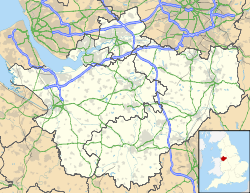- St Mary's and St Helen's Church, Neston
-
St Mary's and St Helen's Church, Neston 
St Mary's and St Helen's Church, Neston,
from the southwestLocation in Cheshire Coordinates: 53°17′21″N 3°03′51″W / 53.2892°N 3.0643°W OS grid reference SJ 292 775 Location Neston, Cheshire Country England Denomination Anglican Website Neston, St Mary and St Helen Architecture Status Parish church Functional status Active Heritage designation Grade II* Designated 27 December 1962 Architect(s) J. Francis Doyle Architectural type Church Style Gothic, Gothic revival Completed 1875 Specifications Materials Red sandstone
Slate tiled roof with red tile crestingAdministration Parish Neston Deanery Chester Archdeaconry Wirral South Diocese Chester Province York Clergy Vicar(s) Rev Neill Robb St Mary's and St Helen's Church, Neston is in the town of Neston, Cheshire, England. The church has been designated by English Heritage as a Grade II* listed building.[1] It is an active Anglican parish church in the diocese of Chester, the archdeaconry of Chester and the deanery of Wirral South. Its benefice is combined with those of St Michael, Little Neston, and St Thomas the Apostle, Parkgate.[2]
Contents
History
The presence of a priest at Neston is recorded in the Domesday Book. The earliest written evidence of a church on the site dates from around 1170 when a church was founded by Ralph de Montalt, a baron of the court of the Earl of Chester. It is likely that an earlier church was on the site because when the floor was being relaid during the 19th century, fragments of pre-Conquest crosses were found.[3] These were later shown to be "hiberno Norse" or Viking Age in origin. A further fragment was discovered in the church's belfry in the 1980s.[citation needed] These fragments are now mounted at the west end of the church.[1] During the 18th century there was disagreement between some of the parishioners and the churchwardens when galleries were erected. The addition of the galleries caused damage to the fabric of the church and in 1871 an inspecting architect reported that the building was unsafe.[3] Consequently in 1874–75 the main body of the church was rebuilt by J. Francis Doyle, reusing some of the Norman material[4] in Early English style.[3]
Architecture
Exterior
The church is built in sandstone. The roofs are of slate with a red tile ridge.[1] The tower is the only old part of the church remaining. Richards describes it as "a rugged gargoyled pile of masonry with very little architectural refinement". The lower part probably includes some re-used Norman material. An additional storey was added to the tower in 1854.[3] The body of the church consists of a six-bay nave with aisles, a two-bay chancel with a north vestry, and a south porch.[1] The aisles are gabled and the nave has a clerestory.[5]
Interior
The font dates from the 16th century; it is octagonal with quatrefoiled panels. The only memorial of importance is a carved stone in memory of a 14th-century priest.[3] Some of the stained glass windows are designed by Edward Burne-Jones[6] and made by Morris & Co.; others are by Kempe.[1] Between the tower and the nave are elaborate wrought iron gates to the memory of Reginald Bushell who died in 1904.[7]
The three-manual organ was built in 1900 by Forster and Andrews.[8] The ring consists of eight bells. Four of these are by Rudhall of Gloucester dated 1731; the other four are by Mears and Stainbank of the Whitechapel Bell Foundry and are dated 1884.[9] The parish registers begin in 1559 and record the baptism in the church in 1761 of Emma Lyon, who was later to become Lady Hamilton. The churchwardens' accounts date from 1701.[3]
External features
In the churchyard is a sundial dated 1717 consisting of a red sandstone vase-baluster on a square base. It is listed Grade II.[10] Close to the church, and also listed Grade II, is a hearse house built in red sandstone with a slate roof and red ridge tiles.[11]
References
- ^ a b c d e "Church of St Mary and St Helen, Neston", The National Heritage List for England (English Heritage), 2011, http://list.english-heritage.org.uk/resultsingle.aspx?uid=1387671, retrieved 2 May 2011
- ^ Neston, St Mary and St Helen, Church of England, http://www.achurchnearyou.com/neston-st-mary-st-helen/, retrieved 13 October 2009
- ^ a b c d e f Richards, Raymond (1947), Old Cheshire Churches, London: B. T Batsford, pp. 255–259
- ^ Salter, Mark (1995), The Old Parish Churches of Cheshire, Malvern: Folly Publications, p. 58, ISBN 1-871731-23-2
- ^ Hartwell, Claire; Hyde, Matthew; Hubbard, Edward; Pevsner, Nikolaus (2011) [1971], Cheshire, The Buildings of England, New Haven and London: Yale University Press, pp. 501–502, ISBN 978-0-300-17043-6
- ^ Tourism honour for a fine old church, The Church of England: Diocese of Chester, http://www.chester.anglican.org/newsitems/neston1006v2.htm, retrieved 5 October 2007
- ^ Morant, Roland W. (1989), Cheshire Churches, Birkenhead: Countyvise, p. 161, ISBN 0-907768-18-0
- ^ Neston St. Mary and St. Helen, British Institute of Organ Studies, http://www.npor.org.uk/cgi-bin/Rsearch.cgi?Fn=Rsearch&rec_index=A00056, retrieved 11 August 2008
- ^ Neston SS Mary and Helen, Dove's Guide for Church Bell Ringers, http://dove.cccbr.org.uk/detail.php?searchString=neston&Submit=++Go++&DoveID=NESTON, retrieved 11 August 2008
- ^ "Churchyard sundial west of Church of St Mary and St Helen, Neston", The National Heritage List for England (English Heritage), 2011, http://list.english-heritage.org.uk/resultsingle.aspx?uid=1387672, retrieved 2 May 2011
- ^ "Hearse house west of Church of St Mary and St Helen, Neston", The National Heritage List for England (English Heritage), 2011, http://list.english-heritage.org.uk/resultsingle.aspx?uid=1387673, retrieved 2 May 2011
Categories:- Church of England churches in Cheshire
- Grade II* listed buildings in Cheshire
- Grade II* listed churches
- English Gothic architecture
- Gothic Revival architecture in Cheshire
- Diocese of Chester
Wikimedia Foundation. 2010.

